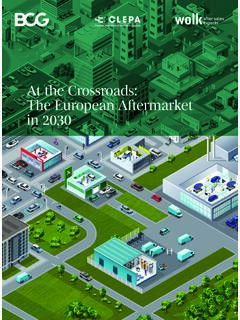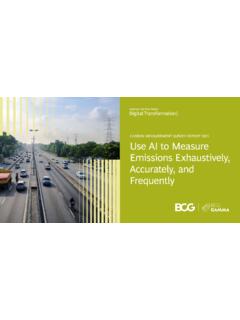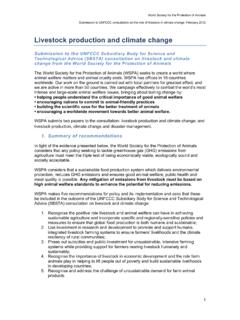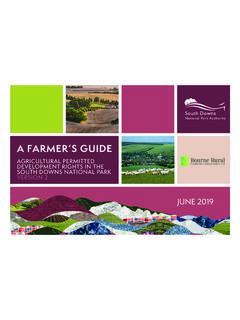Transcription of The Protein Transformation - Boston Consulting Group
1 Food for Thought The Protein TransformationMarch 2021By Bj rn Witte, Przemek Obloj, Sedef Koktenturk, Benjamin Morach, Michael Brigl, J rgen Rogg, Ulrik Schulze, Decker Walker, Elfrun Von Koeller, Nico Dehnert, and Friederike Grosse-HolzBoston Consulting Group partners with leaders in business and society to tackle their most important challenges and capture their greatest opportunities. BCG was the pioneer in business strategy when it was founded in 1963. Today, we work closely with clients to embrace a transformational approach aimed at benefiting all stakeholders empowering organizations to grow, build sustainable competitive advantage, and drive positive societal diverse, global teams bring deep industry and functional expertise and a range of perspectives that question the status quo and spark change.
2 BCG delivers solutions through leading-edge management Consulting , technology and design, and corporate and digital ventures. We work in a uniquely collaborative model across the firm and throughout all levels of the client organization, fueled by the goal of helping our clients thrive and enabling them to make the world a better a pure play global pioneer with privileged access in the Food ecosystem, Blue Horizon has shaped the growth of the alternative proteins market. The company aims to transform the global food industry through impact capital and value creation, and invests across the lifecycles of companies that are mission aligned to replace animal proteins with healthy and sustainable alternative sources of Protein .
3 Blue Horizon was founded by Roger Lienhard in 2016 and is based in Zurich. To date, the company has raised over USD 650 million and invested in more than 50 companies in the alternative Protein sector. Its business model offers an attractive opportunity to invest in the evolution of the global food ecosystem while contributing to a healthy and sustainable world. Alternative Proteins in Context 04 The Promise of Parity08 A Fast-Growing Market14 What s for Dinner?16 Developing the Protein Value Chain Plant-Based Alternatives Microorganism-Based Alternatives Animal-Cell-Based Alternatives25 Expanding the Protein Market29 Investing in Alternative Proteins: The Status Quo31 The Investment Outlook for Alternative Proteins Technology Plays Industrialization and Platform Plays Challenges to Growth37 Conclusion39 GlossaryAlternative Proteins in Context Boston Consulting Group X BLUE HORIZON 2In just the past few years, alternative proteins have morphed from a niche product to a mainstream phe-nomenon.
4 Plant-based meats are now a fixture at fast-food restaurants around the world, plant-based milk is a household staple, and you can taste meat grown from animal cells in restaurants in Singapore and we see today is only the beginning of the Protein Transformation . Based on our analysis, by 2035, every tenth portion of meat, eggs, and dairy eaten around the globe is very likely to be alternative. That s a lot. If the alternative- Protein market were a country, by then it would be a top-50 econo-my, larger than Finland s 2020 GDP. Is this unrealistic? Not at all. And it could be much more, if all four of the domi-noes now lined up were to tip first domino is already falling: public concern for the climate and, more broadly, sustainability is rife.
5 Many consumers want to reduce the amount of animal Protein in their diets, especially if they can do it without sacrificing taste or paying more. In addition, fully 85% of investors now incorporate environmental, social, and corporate governance (ESG) criteria into their investment strategies. We predict that, taken together, these concerns will gener-ate enough consumer demand and investor interest to tip over the second domino: refinement and scaling of existing technologies to unlock parity, when the taste, texture, and price of alternative proteins closely match those of animal proteins. The first two dominoes are all that s needed to allow alternative proteins to capture 11% of the global Protein market by 2035, our base-case growth estimate.
6 What if the industry can generate even more momentum? Step changes in alternative- Protein technology, whether at incumbent food companies or startups and supported by public or private investment, could lead to rapid gains in production efficiency, better taste and texture, and lower cost. The result: the third domino falls, leading to earlier parity and a 16% market share by 2035. The final domino could fall if regulators give it a push. Higher carbon prices and support for farmers transitioning from animal agriculture to alternative- Protein inputs could boost consumption to 22% by 2035. At that rate, Europe and North America would reach peak meat by 2025, and then the consumption of animal Protein in those markets would actually begin to rise of alternative proteins is a Transformation , not a revolution.
7 Several major incumbent meat companies are already redefining themselves as Protein companies, making and marketing their own alternatives. This makes sense, given the size of the prize. We estimate that alterna-tive- Protein revenues will reach $290 billion in 2035, with the profits distributed throughout the value chain: to the startups and incumbent food companies producing alter-natives, the upstream players providing the industry with the inputs and tools needed to unlock these revenues, and the investors willing to support their aside, the Protein Transformation can make an enormous contribution to the efforts to combat climate change. In our base case, by 2035, the shift to plant-based meat and eggs alone will have saved more than 1 gigaton of That s the equivalent of Japan going completely carbon neutral for an entire Eating that much plant-based Protein would save enough water to supply the city of London for 40 years3 and make a major contribution to food security and our planet s biodiversity.
8 Alternative proteins also open up an opportunity for indi-viduals to contribute to the fight against climate change. For instance, every portion of spaghetti Bolognese made with plant-based meat avoids as much greenhouse gas as a new car emits when driven 10 kilometers. Nine out of ten of the world s favorite dishes will have a realistic alternative by what does the Protein Transformation taste and feel like, and how much will it cost the consumer? Good news: it will require few material sacrifices. As alternative pro-teins reach parity with animal proteins in taste, texture, and price, they can replace animal Protein in 90% of the world s ten favorite dishes, from burritos to dim sum.
9 These alternatives won t require new recipes, change the taste of what people love to eat, or cost a lot. Making that Bolognese sauce with alternative meat will be just as easy and taste just as good. It also won t burn a hole in consum-ers FOOD FOR THOUGHTIn this first-of-its-kind report, we crystallize the expertise of the alternative- Protein field, on the basis of a recently conducted survey and more than 40 interviews with indus-try veterans, researchers, and startup entrepreneurs. We provide detailed forecasts of the growth potential of the market for alternative plant-, microorganism-, and animal- cell-based proteins that can directly replace conventional animal Protein , excluding traditionally plant-based foods such as pulses, tofu, and tempeh.
10 We support our model with deep dives into the relevant Protein production tech-nology. From this body of knowledge, we then identify the most exciting investment themes along the value also aim to answer key questions posed by all stake-holders, including farmers, incumbent food companies, startups, investors, and consumers: How will parity deter-mine the future growth of the market? What will be re-quired to bring each type of alternative Protein to parity, and when will that happen? How can investors both sup-port and benefit from its growth? The Promise of ParityAlternative proteins could soon match animal Protein in taste, texture, and price, fueling widespread FOOD FOR THOUGHTC onsumers appetite for alternative proteins is growing, as animal-free Protein emerges as a healthy choice.














